By now, almost any self-respecting art institution has digitized some part of its collection. However, the design of the typical "virtual museum" frequently fails to rise above the level of a database intended more for administrative purposes. The artworks are often shown at low resolution if not in thumbnail format, precluding any meaningful experience on the part of internet navigators. Some museums have attempted to reach a wider audience by including custom-made content via some innovative presentation form.Peter Gorgels, "Rijksstudio: Make Your Own Masterpiece!," MW2013: Museums and the Web 2013, The annual conference of Museums and the Web | April 17–20, 2013 | Portland, OR, http://mw2013.museumsandtheweb.com/paper/rijksstudio-make-your-own-masterpiece/ Others have assumed a wait-and-see attitude.
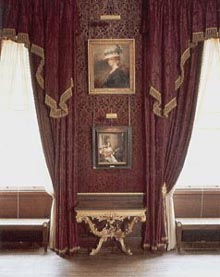
What is certain is that digitization, which can no longer be postponed, raises existential questions for art institutions. How will the elevated costs of digitalization be recovered? Why go to a museum if you can enjoy the same artworks at your leisure on the nearest computer monitor? By overexposing works of art, will their "aura" be diminished, as Walter Benjamin predicted? Will paintings become "marketing instruments" in the hands of powerful museums? Furthermore, some institutions feel that the loss of the economic control over their intellectual property assets will erode their unquestioned authority as the custodians of the cultural value of the objects they possess and as gatekeepers of authenticity.
The most recent development in digital strategy of artworks of the past is the Open Content Project policy pioneered by the Rijksmuseum, the Getty and the Washington National Gallery of Art. These forward-looking institutions provide not only free access to high-quality images of the objects in their collections of a level unthinkable only a few years ago, but have lifted any copyright restrictions whatsoever in the hopes of encouraging engagement of the general public with art and stimulating contemporary artistic production.
In regards to the Open Content Project recently launched by the Getty, CEO Jim Cuno stated "The Getty was founded on the conviction that understanding art makes the world a better place, and sharing our digital resources is the natural extension of that belief," Thus, the move to offer high-quality images of their artworks free of copyright and fee is "an educational imperative. Artists, students, teachers, writers, and countless others rely on artwork images to learn, tell stories, exchange ideas, and feed their own creativity." In any case, there is little doubt that technological innovation is reshaping the role and mission of museums as producers and distributors digital images exposing them contemporarily to threats and opportunities which are only now coming into view.
Almost all of the institutions which house one or more Vermeer paintings have a website in which their Vermeer works are represented in some way. Some have allotted low quality images and minimum information while other, such as the Rijksmuseum, the Metropolitan of New York and the National Gallery of Washington provide navigators with in-depth information and spectacular high-resolution digital images. Furthermore, a few museum website few provide innovative tools for exploring art history such as timelines and essays on special topics. These sites have been signaled with four or five stars.
It is now possible to download, free of charge digital images of an increasing number of Vermeer paintings.
ATTENTION!
- Please note that the following information is up-to-date as of August 3, 2023 but may have changed since then.
- If you are traveling specifically to see one or more paintings by Vermeer, always contact the museum beforehand to be sure it is on display at the moment you plan to visit. Paintings are frequently on temporary loan or in restoration.
- Keep track of the temporary exhibitions by viewing the complete Vermeer catalogue index.
| part 1 | |
| Rijksmuseum |
Amsterdam, Netherlands |
| New York Metropolitan Museum of Art |
New York, U.S.A. |
| National Gallery of Art
|
Washington D.C., U.S.A. |
| National Gallery
|
London, England |
| part 2 | |
| Mauritshuis |
The Hague |
| Frick Collection |
New York, U.S.A. |
| Musée du Louvre |
Paris, France |
| Staatliche Museen Preußischer Kulturbesitz, Gemäldegalerie |
Berlin, Germany |
| Staatliche Kunstsammlungen, Gemäldegalerie |
Dresden, Germany |
| Städelsches Kunstinstitut |
Frankfurt am Main, Germany |
| part 3 | |
| Herzog Anton Ulrich-Museum |
Brunswick, Germany |
| Kunsthistorisches Museum |
Vienna, Austria |
| National Gallery of Ireland |
Dublin, Ireland |
| Isabella Stewart Gardner Museum (stolen, no longer in gallery) | Boston, U.S.A. |
| Kenwood House |
London, England |
| The Royal Collection, Buckingham Palace |
London, England |
| National Gallery of Scotland |
Edinburgh, Scotland |
| The Leiden Collection |
New York, U.S.A. |
THE MAURITSHUIS
Museum Home Page: http://www.mauritshuis.nl/en/



Despite its limited number of artworks, Het Mauritshuis ("The Maurice House") remains one of the most renowned art collections in Europe. Its approximately 800 paintings, primarily from the Dutch Golden Age, comprise first-rate works by seventeenth-century Dutch masters such as Johannes Vermeer, Rembrandt van Rijn, Jan Steen, Paulus Potter, and Frans Hals, as well as several works by the German painter Hans Holbein the Younger. Originally the residence of Count John Maurice of Nassau, the seventeenth-century building of the Mauritshuis is the property of the government of the Netherlands and is listed in the top one hundredDutch heritage sites.
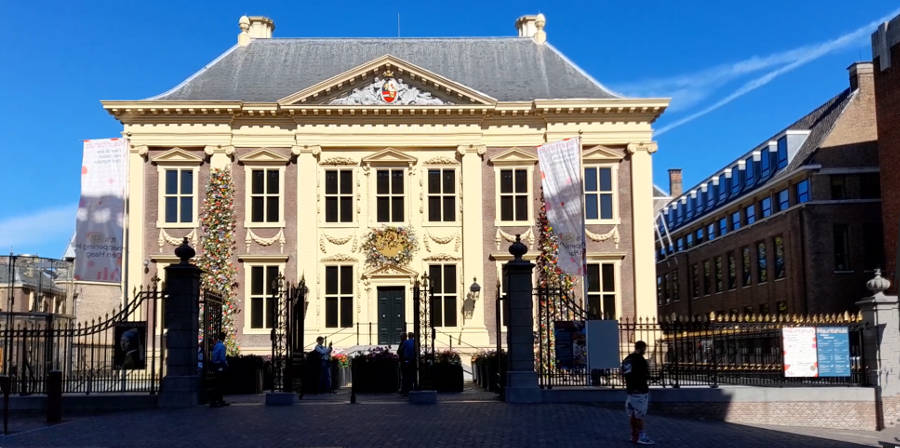
The exterior of the Mauritshuis has been renovated several times since its completion in 1644. Recently, an ambitious expansion project was carried out to create a museum suitable for the 21st century, moving the entrance to the front courtyard, thereby restoring the building's stately appearance. The surface area of the entire museum was doubled, creating more space for art, exhibitions, education, and events.
The relatively small size of the gallery, along with the ambiance and exceptional quality of the pictures on display, make the Mauritshuis one of the most congenial places for getting to know Dutch seventeenth-century painting. The gallery houses two of Vermeer's masterpieces: Girl with a Pearl Earring, View of Delft, as well as an early work, Diana and her Companions.

The Mauritshuis has published an introductory catalogue on Vermeer, which remains of great use even in the age of the internet. It is filled with crisp images of many of Vermeer's paintings along with numerous details, and a host of relative documents and works by other artists. The text is expertly written and informative. Especially appreciable are the large reproductions of the three works by Vermeer. Click here to purchase Vermeer in Mauritshuis
Mauritshuis Online
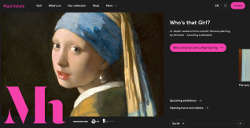
In 2021, Mauritshuis launched its new website design and a renewed multimedia tour. Digital agency DEPT® supported the museum with strategy, technology, and digital marketing.
The changes Mauritshuis implemented were created to put the art collection into a different perspective and provoke interest among other target groups. The new design is not only pleasing to the eye but allows for more interesting and user-friendly digital experiences.
Sandra Verdel, Project Manager Digital Engagement at Mauritshuis: "With the new website and multimedia tour we want to position the Mauritshuis as an approachable and accessible museum, that touches you personally with a collection that you must have seen once in your lifetime. We want to achieve this by telling more stories, but also by giving the floor to other people to speak about the collection."
On the occasion of its reopening, the Mauritshuis has also renovated its website and has added new high-resolution images of their Vermeer paintings which can be viewed with a zoom feature or downloaded to one's hard disk. The downloadable images are lower resolution than the zoom versions, and the design of the Mauritshuis website is elegant, the visuals refined and navigation presents no problems. The site also offers short films, the latest news and practical information. The collection's website features a special story dedicated to the Girl with a Pearl Earring (Who's that Girl?). Other Stories can be found here.
LINKS:
Mauritshuis Information
- Location: Plein 29, 2511 CS Den Haag, Netherlands
- Opening Hours: Monday 1 p.m. 6 p.m. | Tuesday - Sunday 10 a.m. - 6 p.m. | closed on 25 December and 1 January.
- Contact: tel: +31 (0)70 30 23 456
Fax: +31 (0)70 - 365 38 19 - Email: mail@mauritshuis.nl
- Museum Shop: https://shop.mauritshuis.nl/en/?utm_source=MHwebsite&utm_medium=Button&utm_campaign=MHwebEN
- Products Inspired by Vermeer:
https://shop.mauritshuis.nl/en/vermeer/ - Tickets: book here; adults € 19 | youth (under 19) Free | groups (less than 15 people) € 17 | ICOM, Museum Card, Vriendenloterij VIP-card, Rembrandt Society &Friends of the Mauritshuis free | studentcard € 12,50
- International Friend in The Hague (€ 60 per year, €80 for a couple*) Includes: unlimited free entrance to the museum | Free subscription to the museum's bilingual Mauritshuis Magazine | Invitations to exclusive previews of exhibitions | Lectures and talks from leading art specialists | 10% reductions on purchases in the museum shop | Exclusive excursions to places of interest in the Netherlands | Family activities for all ages | Hands-on activities and interactive workshops in English. (*Some of the activities will require an extra contribution.)
- Social Media: Facebook | Instagram | Twitter
Planning a trip to The Hague? Click here.
THE FRICK COLLECTION
Museum Home Page : http://www.frick.org/


Together with the Mauritshuis, the Frick Collection is one of the pre-eminent small art museums of the world, with an exceptionally high-quality collection of old master paintings and fine furniture housed in six galleries within the former residential mansion of the American industrialist, Henry Clay Frick.
Built between 1913 and 1914 from designs by the firm Carrère and Hastings, the Frick is set back from Fifth Avenue by an elevated garden punctuated by three magnificent magnolia trees, not far from the Metropolitan Museum of Art. After Frick's death in 1919, his daughter, Helen Clay Frick, continued to expand the collection. Frick left 137 paintings on site at the Frick Collection but an additional fifty paintings in all have been acquired over the years by the Trustees from an endowment provided by the founder and through gifts and bequests. The building was restored and opened to the public on December 16, 1935, and was restored again in 1977 and in 2011.
After a two-year-long $16,000,000 renovation of the 85-year-old Breuer building, the Frick Collection will reopen its historic mansion by the end of 2024, although no exact date has been specified. The Collection is currently housed at the former Whitney Museum, redubbed the "Frick Madison" at 945 Madison Avenue and 75th Street.
When the Frick reopens, the public will be able to access its second floor for the first time, and the museum is moving the famous Boucher room back to its original location on that level. There will also be new conservation laboratories and an auditorium with a state-of-the-art audio and visual system.
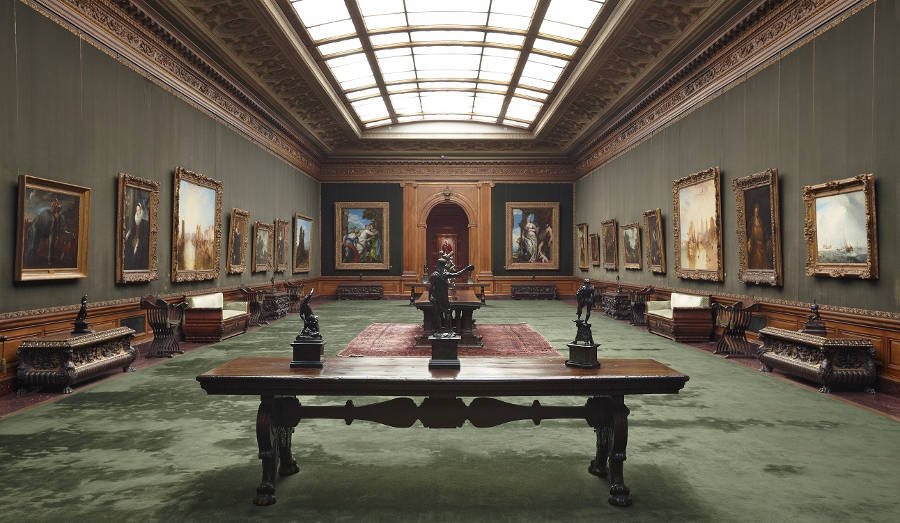
Many of the collection's paintings remain arranged according to Frick's original design. The collection features some of the best-known paintings by major European artists, as well as numerous works of sculpture and porcelain. It also has a fine collection of 18th-century French furniture, Limoges enamel, and Oriental rugs. Although the museum cannot lend the two-thirds that belonged to Frick, as stipulated in his will, the Frick Collection does lend artworks and objects acquired since his death. Besides its permanent collection, the Frick has always organized small, highly-focused temporary exhibitions.
The collection houses three exquisite Vermeers: Officer and Laughing Girl, Girl Interrupted in her Music, and Maid and Mistress.
Established in 1924, the Frick Art Reference Library quickly became a prime resource for art historians and students. The library's collections focus on art of the Western tradition from the fourth century to the mid-20th century, and chiefly include information about paintings, drawings, sculpture, prints, and illuminated manuscripts.
The Frick Online
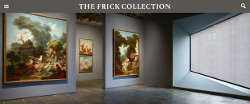
The Frick Collection website has been completely revamped, with the addition of an array of new programs and features. The site's layout is sober and the visuals are agreeable. Content is well organized and navigation presents no problems. For Vermeer enthusiasts, the current Zoomify feature permits viewers to inspect all three Vermeers in detail, but unfortunately, the colors are unusually poor, with a decidedly unnatural yellow cast.
In 1998, the Frick Collection was one of the first art museums to offer a Virtual Tour. Due to its popularity it was updated and expanded to include all of the public spaces and gardens. The tour features links to the prime works of art and a history of the galleries and architecture. A full screen version is also available. Vermeer enthusiasts will want to visit the South Hall where the Officer and Laughing Girl and the Girl Interrupted in her Music are hung. In the opulent West Gallery, Vermeer's Mistress and Maid keeps company with a group of absolute masterworks of European painting, displayed in what is perhaps one of the most user-friendly environments for art lovers on the planet. From a fixed point in each room, the viewer can rotate his line of sight 360 degrees allowing him to get a feel of the unique ambience for which the Frick is rightly renowned.
For the art historian and researcher, the Frick Collection and Frick Art Reference Library have published various online databases including the Archives Directory for the History of Collecting in America, and the unique Montias Database of Seventeenth-Century Dutch Art Inventories, created and donated by the American economist-turned-Vermeer-biographer, John Michael Montias.
LINKS:
- Officer and Laughing Girl
- Girl Interrupted at her Music
- Mistress and Maid
- Virtual tours
- Videos
- Video: Arthur K. Wheelock Jr.: "The Making of an Icon: Girl with a Pearl Earring"
- Esmée Quodbach, "Henry K. Frick and Vermeer"
- Audio Presentations of the Three Frick Vermeers
Frick Collection Information
- Location: The Frick Collection 1 East 70th Street (between Madison and Fifth Avenues), New York, NY 10021–4967
- Opening Hours: The collection is open six days a week: Tuesday through Saturday: 10:00 a.m. to 6:00 p.m., Sundays: 11:00 a.m. to 5:00 p.m.
- Collection closed: Mondays, New Year's Day, Washington's Birthday, Martin Luther King Day, Memorial Day, Independence Day, Labor Day, Columbus Day, Thanksgiving Day and Christmas Day
- Collection Limited Hours: open 11:00 a.m. to 5:00 p.m. Lincoln's Birthday Election Day
- Contact: tel: 212-288-0700, fax: 212-628-4417
- Email: info@frick.org
- Social Media: Facebook Instagram Twitter
Research at the Frick
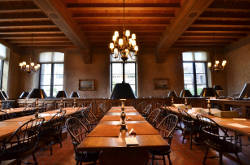
The Frick's Library book and photograph research collections relate chiefly to paintings, drawings, sculpture, prints, and illuminated manuscripts from the fourth to the mid-twentieth centuries by European and American artists. Known internationally for its rich holdings of auction and exhibition catalogs, the Library is a leading site for collecting and provenance research. The collections can be searched using the online catalog, FRESCO. It contains records for the book collection, photo archive collection, auction catalogs collection, microfilm collection, and electronic resources. Particularly interesting for researchers in the Frick Collection Digital Archive.
MUSÉE DU LOUVRE
Museum Home Page: http://www.louvre.fr/en


The Louvre's painting collection is one of the richest in the world, representing all periods of European art up to Impressionism. The vast museum complex is situated on the right bank of the Seine, in the city's 1st arrondissement. Housed in the Louvre Palace, it was originally built in the late 12th to 13th century under Philip II, after which it was progressively extended until it was transformed into a museum in the 18th century.
The Museum covers an area of about 210,000 square meters, with about 60,600 square meters devoted to public exhibition space. As of 2021, it contains more than 380,000 objects and displays 35,000 works of art from prehistory to the 21st century, exhibited over eight departments.
Among the many significant works housed at the Louvre are the Mona Lisa by Leonardo da Vinci, the Winged Victory of Samothrace, the Venus de Milo, and Liberty Leading the People by Eugène Delacroix.
Since 1794, the Department of Paintings has been organized into national schools. With the completion of the Grand Louvre Project, the Department covers an exhibition area of around 17,850 m², distributed among the various schools.
The Grand Louvre, initiated by French President François Mitterrand in 1981, was a decade-long project aimed at expanding and remodeling the Louvre by relocating the French Finance Ministry, which had been housed in the Louvre's northern wing since 1871, to a different location. The centerpiece of the Grand Louvre is the Louvre Pyramid, designed by Chinese-American architect I. M. Pei, which was the project's most controversial component. Although the Grand Louvre was substantially completed in the late 1990s, its final elements were not finalized until the 2010s.
There are two Vermeer's in the Louvre's collection, The Astronomer and The Lacemaker.
The Louvre Online

Following the lead of other major museums, in 2012, the Louvre has recently renovated its website, by Art & Object. Moreover, the website features original content as such as live and recorded podcasts, lectures, concerts, web series, animated stories, filmed exhibition walk-throughs, interviews, and more. The content is organized around art history themes but also includes current happenings at the museum such as conservation campaigns and art-related professions. A special feature for children and families known as the Louvre Kids app was created in spring 2020, which includes filmed storytime sessions, a gallery of works, and tales to listen to at home.
Oddly, relatively scarce attention is dedicated to its two Vermeer masterpieces, even though the museum boasts The Lacemaker is the second most popular painting in the universally aclaimed collection. Other than the disappointing low-resolution images of their two Vermeers, the museum offers little more than basic information, history, exhibitions, and a discreet bibliography of each work.
The website offers a variety of means to explore the vast collection.
LINKS:
- The Lacemaker "Special" Feature
- Lacemaker
- The Astronomer
- Explore the Collection Database
Musée du Louvre Information
- Location: Palais Royal-Musée du Louvre, Paris
- Opening Hours: Monday, Wednesday, Thursday, Saturday, and Sunday 9:00 to 6:00 p.m., Friday 9:00 to 9:45 PM | Friday last entry: 1 hour before closing | Rooms are cleared 30 minutes before closing. The museum is closed on 1 January, 1 May and 25 December, but remains open on all other public holidays unless they fall on a Tuesday, the museum’s day of closure.
- Tickets: The Museum strongly advises visitors to book a time slot in advance to guarantee their admission to the museum in case of overcrowding. Tickets can be purchased online.
- Contact: tel: +33 1 40 20 50 50 fax: +33 1 40 20 54 52
- Email:info@louvre.fr
- Postal Address: Musée du Louvre F-75058 Paris, Cedex 01 FRANCE
- Social Media: Facebook Instagram Twitter
STAATLICHE MUSEEN PREUSSISCHER KULTURBESITZ, GEMÄLDEGALERIE
Museum Home Page: https://www.smb.museum/museen-einrichtungen/gemaeldegalerie/home/


The Gemäldegalerie (Picture Gallery) possesses one of the world's finest collections of European art from the 13th to 18th century. After the collection was founded in 1830, it was systematically built up and refined. The exhibition includes masterpieces by artists representing various epochs of art history, including Vermeer, Van Eyck, Brueghel, Dürer, Raphael, Titian, Caravaggio, Rubens, and Rembrandt.
The Octagonal Rembrandt room enjoys a key position at the heart of the museum. The sixteen works by this artist form one of the largest and highest quality collections of Rembrandt paintings. They are complemented by additional gems of Dutch and Flemish painting from the seventeenth century. Portraits, genre paintings, interiors, landscapes, and still lifes illustrate certain artists' predilections for particular types of themes.
The museum houses two of Vermeer's most evocative pieces, Woman with a Pearl Necklace and The Glass of Wine.
The Gemäldegalerie Online

After years of digital indifference, the Berlin Gemäldegalerie has begun to bolster its online presence, having recently added a page dedicated to each of its two masterworks by Vermeer, with, however, minimal information can be downloaded.
links:
- Girl with a Pearl Necklae
- The Glass of Wine
- Collection Online
- The Gemäldegalerie has recently added a useful page that notifies when their paintings are on loan.
Staatliche Museen Preußischer Kulturbesitz, Gemäldegalerie Museum Information
- Location: Gemäldegalerie Stauffenbergstraße 40 (Museum Entrance: Kulturforum, Matthäikirchplatz) 10785 Berlin
- Opening Hours: Mon. closed Tue 10:00 a.m.–6:00 p.m. Wed. 10:00 a.m.–6:00 p.m. Thu 10:00 a.m.–10:00 p.m. Fri. 10:00 a.m.–6:00 p.m. Sat. 10:00 a.m.–6:00 p.m. Sun. 10:00 a.m.–6:00 p.m.
- Public Holidays: On regular German public holidays, the museums are open at normal weekday opening times. Public holidays include: Good Friday, Easter Saturday, Easter Sunday, Easter Monday (always open), May Holiday, Ascension Day, Pentecost Saturday, Pentecost Sunday, Pentecost Monday (always open), Day of German Unity
- Contact: tel: 030/2662101 fax: 030/2662103
- Email: curatorial-records@nga.gov
- Visitors Services: curatorial-records@nga.gov
- Social Media: Facebook Instagram
STAATLICHE KUNSTSAMMLUNGEN, GEMÄLDEGALERIE
Museum Home Page: https://www.skd.museum/en/


The world-renowned Dresden Old Masters Picture Gallery (Gemäldegalerie Alte Meister) is founded on its outstanding collection of masterpieces of European art. Housed in the Zwinger complex, among the primary focuses of its holdings are Italian painting of the Renaissance—as exemplified by major works of Raphael, Giorgione, and Titian—as well as works in the Mannerist and Baroque styles. Of equal significance is the inventory of Dutch and Flemish paintings of the 17th century. The Gallery's most famous painting is perhaps Raphael's Sistine Madonna (1513), renowned for the two cherubs at the Madonna's feet, which have been reproduced countless times. Other notable works in the collection include Sleeping Venus by Giorgione and Rembrandt's Self-Portrait with Saskia. Not only are Rembrandt and his followers represented with a large number of works of superb quality, but the collection also comprises two extraordinary paintings by Vermeer (The Procuress and the Girl Reading a Letter at an Open Window), Jacob van Ruisdael, and the great Flemish artists Rubens, Jordaens, and Van Dyck.
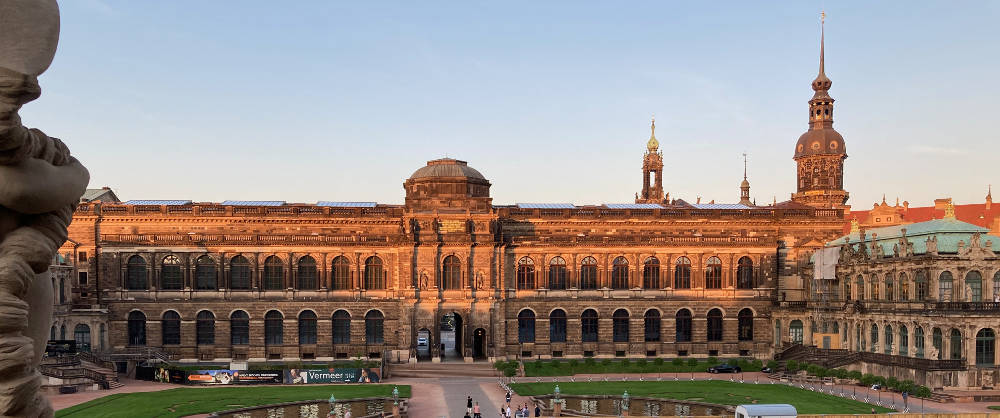 Dresden Old Masters Picture Gallery (2021)
Dresden Old Masters Picture Gallery (2021)
Staatliche Kunstsammlungen, Gemäldegalerie Alte Meister Information
- Location: Gemäldegalerie Alte Meister Zwinger, Semper Building Theaterplatz 1 D-01067 Dresden
- Opening Hours: 10 a.m. to 6 p.m., closed Mondays. Click here for special closure days.
- Contact: tel: +49 (0)3 51 / 4 91 46 19 fax: +49 (0)3 51 / 4 91 46 16
- Email: info@skd.smwk.sachsen.de
- Social Media: Facebook Instagram Twitter
Planning a trip to Dresden? Click here.
STADELSCHES KUNSTINSTITUT
Museum Home Page: https://www.staedelmuseum.de/en/

The Städelsches Kunstinstitut, more commonly known as the Städel Museum, is one of the most prominent and oldest art museums in Germany. It was established by the Frankfurt banker and merchant Johann Friedrich Städel in 1815, and today houses an impressive collection that covers major European artistic movements from the early 14th century to the present day. The collection includes masterpieces from artists such as Sandro Botticelli, Rembrandt van Rijn, Vermeer, Claude Monet, Pablo Picasso, and many more.
In addition to its collection of paintings, the museum also boasts 100,000 drawings and prints, as well as 600 sculptures. It has a library of 115,000 books and a large photographic collection.
The Städel Museum has undergone several renovations and expansions to accommodate its growing collection. Most notably, an underground extension was completed in 2012 to house the museum's collection of contemporary art. The Museum contains one painting by Vermeer, The Geographer.

Städelsches Kunstinstitut Information
- Location:Städel Museum, Schaumainkai 63, Frankfurt am Main 60596
- Opening Hours: Tue., Wed., Fri., Sat., Sun. 10 a.m.-6 p.m., Thur. 10 a.m.-9 p.m., Mon. closed
- Tickets: €16 regular,€14 reduced. Buy tickets online.
- Contact:
info@staedelmuseum.de
Tel: 069 - 605098-200 - Newsletter: https://www.staedelmuseum.de/de/newsletter
- Social Media: Facebook Instagram Twitter
Planning a trip to Frankfurt? Click here.